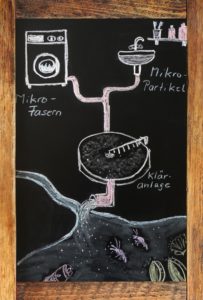 Microfibres is the name given to fibres, which are washed out of textiles in the washing process and which reach sewage treatment plants together with waste water. These can often be made of plastic as most textiles nowadays are based on plastics or blended fabrics. The ecologist Mark Anthony Brown found microplastics on 18 beaches in 6 continents (defined here as ocean rubbish plastic pieces smaller than 1mm). Most were microfibres, which he found particularly at outlets of sewage treatment plants. Tests have shown that a piece of clothing can lose 1900 fibres in washing. Sewage treatment plants cannot filter out these small fibres. We can expect an increase in the pollution of the oceans by microfibres as more and more clothing and other textiles are being manufactured and used using plastics worldwide. 1)
Microfibres is the name given to fibres, which are washed out of textiles in the washing process and which reach sewage treatment plants together with waste water. These can often be made of plastic as most textiles nowadays are based on plastics or blended fabrics. The ecologist Mark Anthony Brown found microplastics on 18 beaches in 6 continents (defined here as ocean rubbish plastic pieces smaller than 1mm). Most were microfibres, which he found particularly at outlets of sewage treatment plants. Tests have shown that a piece of clothing can lose 1900 fibres in washing. Sewage treatment plants cannot filter out these small fibres. We can expect an increase in the pollution of the oceans by microfibres as more and more clothing and other textiles are being manufactured and used using plastics worldwide. 1)
A further source for microplastic can be small plastic particles which are added to cosmetics. When these have been used they enter sewage treatment plants via the waste water, get into waters and finally into the ocean. These additives in cosmetics have various functions, whereby larger particles up to some 800 micrometres are often used as abrasive cleaning pearls in peelings or toothpaste. Smaller particles up to a few micrometres are often found in decorative cosmetics and give creams for example a good property as to application or a lipstick long stability when being applied. 2), 3)
1) Accumulations of microplastic on shorelines worldwide: sources and sinks
Mark Anthony Browne , Phillip Crump , Stewart J. Niven , Emma Louise Teuten , Andrew Tonkin , Tamara Galloway , and Richard C. Thompson
Environ. Sci. Technol., Just Accepted Manuscript DOI: 10.1021/es201811s
Publication Date (Web): September 6, 2011 Copyright © 2011 American Chemical Society http://dx.doi.org/10.1021/es201811s
2) Hintergrundartikel zu Mikropartikel in Kosmetika als Download: www.projektbluesea.de: http://www.projectbluesea.de/media/files/downloads/2.pdf
http://www.projectbluesea.de/media/files/downloads/Micro-Beads.pdf http://www.beatthemicrobead.org/de/
3) Heather Leslie, Review of Microplastics in Cosmetics; Scientific background on a potential source of plastic particulate marine litter to support decision-making; Report R14/29 July 2014;

